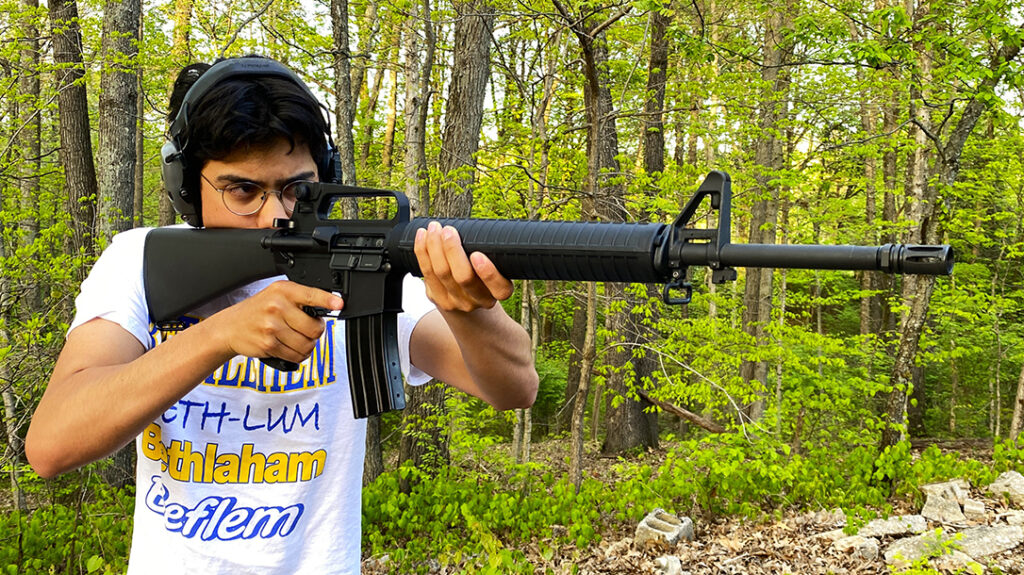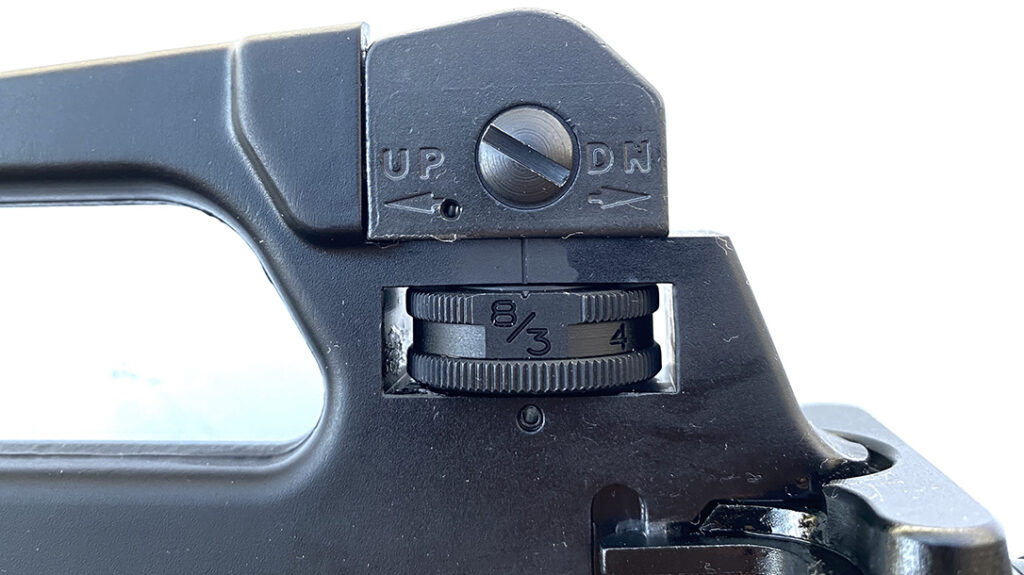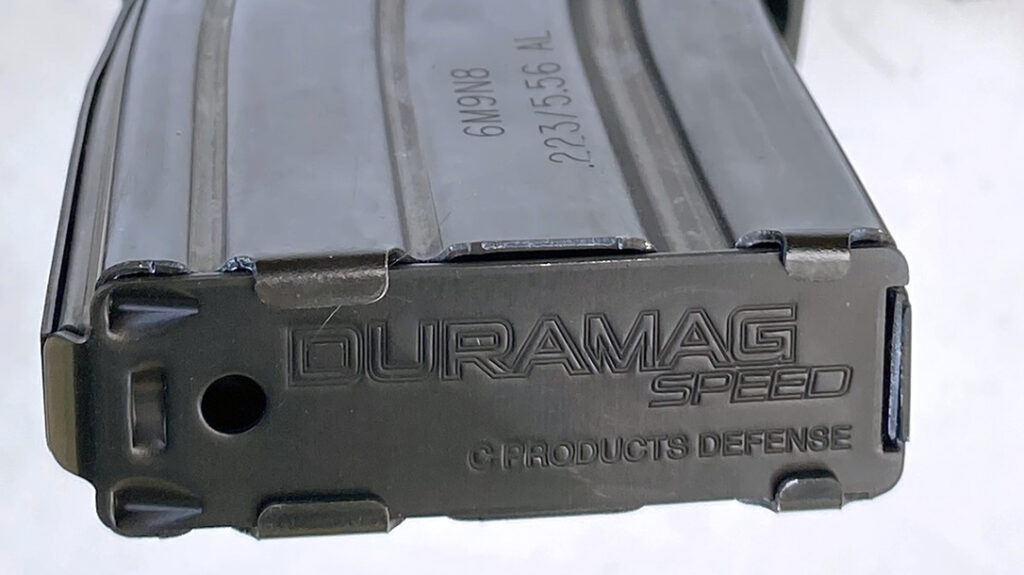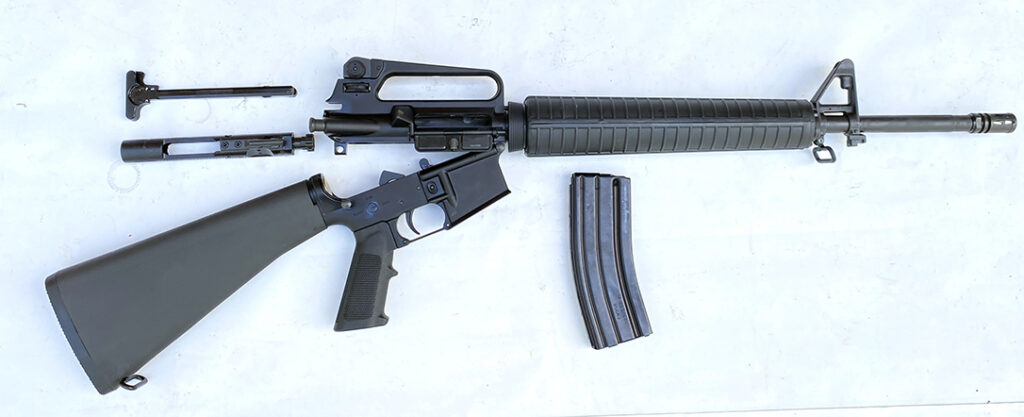One could argue that the M16A2 was the rifle that made the civilian market for AR platform rifles in the 1980s and 1990s. Its predecessor, the M16A1, for all its merits, had some baggage too. Its awful ammunition-related reliability problems in 1966 and 1967 cost lives, and the long American experience in the Vietnam War led to a negative attitudes about our military involvement among both civilians and veterans. In the 1970s, I recall it was rare to hear Vietnam veterans talk about their tour in country. Unlike World War 2 veterans, they were left with the feeling there was little to celebrate about their service. The only civilian semi-auto version of the M16 available was the Colt SP-1 and it was not what you’d call a hot seller. That would change in the next decade.
Springfield Armory SA-16A2 Rifle
The Cold War chugged on into the 1980s, and gradually the public’s bad memories of Vietnam, and the M16A1, receded as America transitioned to an all-volunteer military. The memorable U.S. Army recruiting “Be all that you can be” advertising campaign began in 1981 and was so successful it ran for the next 20 years, spanning many successful non-combat and peace-keeping operations, two small invasions in Grenada and Panama, and a huge military deployment in Saudi Arabia (Operation Desert Shield) followed by huge combat operations against Iraqi forces in 1991 (Operation Desert Storm and Desert Saber).
By the time those big operations in the Middle East took place, pride in our armed forces had been at a sustained high for a decade, and those operations alone created about 147,000 veterans with positive attitudes about their service and their service rifle, which for most was the M16A2. Civilian sales of AR platform rifles, which had been slowly increasing through the 1980s, saw a big jump in the early 1990s.
The M16A2 was an improved M16A1. Many of the M16A2’s new features are still standard on current military and civilian AR platforms. Its heavier barrel was more rigid, and resisted bending and heat better than the thin “pencil barrel” on the M16A1. The faster, one turn in seven twist (1:7 twist) rifling better stabilized heavier, longer bullets, which remain the trend today.
A2 Improvements
The lower receiver became strengthened at the front hinge pin holes and at the buffer tube mounting ring. The upper receiver included a case deflector, enabling safely firing left-handed. A simpler to manufacture round plunger head forward assist replaced the old tear drop style. The elevation adjustable front sight post changed from round to square, providing a crisper sight picture. The new M2 flash hinder, unlike the A1 “birdcage” flash hider, featured a solid bottom. It directed all gas upward to help compensate for muzzle rise. It also prevented the tell-tale dust cloud from revealing the shooter’s position to the enemy when firing prone.
The stock material was upgraded from the old, crack prone cellulose-impregnated phenolic resin plastic of the 1960s to a modern fiber-reinforced polymer plastic that was virtually unbreakable. The A2 pistol grip introduced a finger ridge to help index the hand consistently for better trigger control. Smaller diameter, round, ridged, interchangeable handguards replaced the original triangular style, and the shape of the spring-loaded delta ring that held them in place was changed from straight-sided to flared, making it much easier to hold onto while changing handguards.

A2 Classic Features
The A2 rear sight had windage and elevation adjustment wheels that allowed for quickly re-zeroing the sight for ranges from 200 to 800 yards with the new 62-grain NATO standard M855 ammunition. The adjustment clicks could be heard and felt, and the ranges were marked on the dial. Like the M16A1, the A2 had a flip-type dual aperture, but it was not for changing elevation. The A2 had a large ring aperture to engage targets within 300 meters, where a larger field of view was desirable, and a small ring aperture for more precise aiming at targets beyond 300 meters.
All of these features, as well “U.S. GOVERNMENT PROPERTY” and “BURST” markings, on the receiver, an M16-style bolt carrier, and chrome lining of the barrel are present in the new Springfield Armory SA-16A2. About the only thing I can see that they didn’t copy was the actual three-round burst capability that became the subject of so much controversy when it was substituted for full-auto on the selector.

Springfield Improvements to the Classic Form
But don’t let that get you down. Springfield Armory actually added four discreet improvements to its SA-16A2. Their upper receiver is relieved for M4-style feed ramps, which permits better feeding, the magazine well is more flared to allow for easier insertion of magazines, the bolt and bolt carrier have a Melonite surface treatment to reduce friction and increase resistance to wear and rust, and there’s a hidden ACCU-TITE receiver tensioning screw under the pistol grip to remove any wiggle between the upper and lower receiver
On the range I had the rifle zeroed for testing in no time by bore sighting in on an 11.5 inch bullseye target set 100 yards away. At that range, the bullseye appears to be same thickness as the front sight post, which minimizes windage errors in my sight picture. As per the military manual (TM 9-1005-319-10), rear sight elevation clicks equaled 3.5 cm (1-3/8 in.) and windage clicks were 1.25 cm (1/2 in.) at 100 meters. The 5.3-pound pull, single-stage, military trigger broke cleanly. With the rifle rested on the bench and using the small sighting aperture, I was able to shoot five-shot groups averaging 2.47 inches with Black Hills Ammunition 62-grain Barnes TSX solid copper bullets.

Driving 55s
The rifle was made to shoot 62-grain bullets. Some fast-twist barrels shoot 55-grain bullet loads surprising well, so I tried two I had on hand and got exceptional results. Hornady American Gunner 55-grain JHP and bargain Winchester white box 55-grain FMJ averaged five-shot groups of 1.85 and 2.16 inches respectively. When it comes to shooting with iron sights, vision is usually the limiting factor rather than the rifle or ammunition. When a rifle can shoot groups under 2.5 MOA at 100 yards with iron sights, it’s a pretty darn straight-shooting gun.
In 1997, the more optics flexible, flat-top receiver M16A4 began replacing the M16A2 as America’s standard issue battle rifle, but the M16A2 was still in service in the early 2000s during operations in Afghanistan and Iraq. By 2005, the supremacy of the rifle as the weapon of choice for U.S. Army infantrymen was on the wane when the decision was made to issue the handier M4 carbine to combat units. In 2016 the USMC did the same.

The A2 Rifle Reborn
Shooting Springfield Armory’s SA-16A2, with its 20-inch barrel, reminded me of what a 5.56mm rifle is capable off. What was the military thinking when they went to the 14.-5-inch barrel M4? They were making the best decisions they could for the present and foreseeable needs of the force. The compact M4 carbines have given good service, but their range limitations gave rise to the concept of the Designated Marksman Rifle to do the job the last variant of the M16 rifle series, the M16A4, could have done with ease.
Though the M16A2 is pretty much retired from U.S. military service, many of the improvements it ushered in remain relevant in the current generation of military and civilian AR platforms. Its heavy barrel and adjustable sights ensured it would have a place on the competitive firing line at Camp Perry and other high-power rifle matches around the country, and you’ll still see civilian versions of the rifles there today. I’d expect the Springfield Armory SA-16A2 to take a some places on those firing lines too.
For more info, visit springfield-armory.com.

Springfield Armory SA-16A2 Rifle Specs
- Caliber: .223 Remington/5.56mm NATO
- Operation: Gas-operated, direct impingement, semi-automatic
- Barrel: 20-inch, RH 1:7 twist, chrome lined, ½ x28 threaded muzzle with A2 flash hider
- Overall Length: 39.5 inches
- Weight empty: 7.9 pounds unloaded
- Magazine capacity: Accepts STANAG magazines, 2 aluminum 30 round Duramag included.
- Trigger: Single-stage, 5.3 pound
- Sights: Elevation & windage adjustable A2 rear sight and elevation adjustable square post front sight.
- Stock: Standard Military A2 buttstock w/butt trap storage, 23 degree A2 pistol grip and round forend.
- Accessories: Padded, embroidered Springfield Armory logo, black nylon carrying case.
- MSRP: $1,249

Performance: Springfield Armory SA-16A2 Rifle
| Load | Velocity | Best Group |
| Winchester (White Box) 55-grain FMJ | 3,169 | 1.67 |
| Hornady American Gunner 55-grain JHP | 2,962 | 1.59 |
| Black Hill Ammunition 62-grain Barnes TSX Solid Copper | 2,976 | 2.10 |





Didn’t find what you were looking for?
Read the full article here
